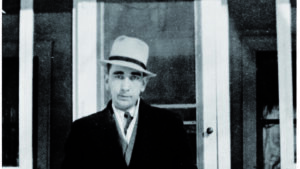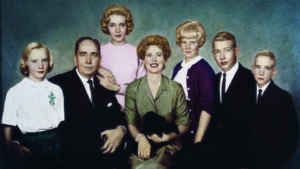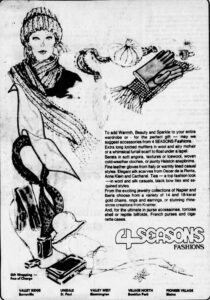Bruce Engelsma Looks Back…and Forward, 50 Years On
A 50-year career at one company is a rare accomplishment. But for Kraus-Anderson Chairman Bruce Engelsma, you could say it’s all relative. As Chairman of the Kraus-Anderson Companies, Bruce follows in the footsteps of his father, Lloyd Engelsma, whose own leadership at KA spanned more than 60 years. Recently Bruce sat down to share some memories and perspectives on what’s changed, and what endures, over the past 50 years.
Photos above: Bruce with Lloyd and Dan Engelsma at Village North Bowl; Breaking ground for KA Headquarters, 2016.
Can we begin by talking a little about your predecessor and your great mentor: Your father, Lloyd. What motivated him? What made him tick?
BRUCE: Yeah, that’s a good question. He was certainly passionate about his work. And, you know, I think it’s kind of surprising that he ended up in the construction business; he could have been successful anywhere.
How did he get into the construction business?
BRUCE: It happened during the Great Depression. He was a student, taking engineering courses at the University of Minnesota and law courses at William Mitchell. To make ends meet he was washing dishes and clearing tables at the Sexton Cafe, which was right next door to Kraus-Anderson’s office. Working there he met Mathew Kraus and Amos Andersen from KA. They offered him a job working in their office, and he made the most of it.
So the career found him.
BRUCE: He just wanted to be successful in life, and when opportunity knocks, you answer. That was how he reacted to life. He was always looking for an opportunity in every situation, and he believed that in every challenging situation there is an opportunity. We keep that message on the walls of our headquarters to this day.

Just a few years later he bought the company from Mr. Kraus and Mr. Andersen. Amazing!
BRUCE: I think he was the most dedicated, hardworking person I know. I mean mentally hardworking. He was always digging into whatever he was working on.
And you witnessed that from a very early age.
BRUCE: When we were little, we would come in on Saturday and sit at his desk and color as he worked. On weekends he’d go out checking construction sites or properties and we’d ride along and help take notes. So, yeah, we just grew up in it.
Also he was always bringing notes home from the office and studying… things that he was working on, or reading multiple newspapers a day, keeping up on what’s going on in the world or watching news programs. It seems to me he was always putting the pieces of things together because as he got to know more people and was solving problems for people, he was also putting possibilities and deals together. Always thinking about what is going on in the world or in business, the trends, challenges, figuring out where the opportunity was and how to grab it.
Does that approach explain how KA moved into real estate ownership and development?
BRUCE: I think that is part of how he got into real estate. He built some projects for others, saw how the deals worked and thought, I can do that. And started doing it. Some of those early developers he was working with, Fred Levy and Lou Gainsley, I think they kind of helped him along towards that.
Another great influence in Lloyd’s life, and your life, was your mother, Fran.

BRUCE: My mom was certainly the nurturer and the one that held people and families and friends together. We learned a lot from her about investing in relationships. She was very serious about managing the household and the family and committed herself to that role with the same passion and commitment that Lloyd threw himself into the work that he did. It was a great partnership.
Was it always a foregone conclusion for you that this was the business you were going to go into?
BRUCE: I think it started clicking when I was in high school. I don’t know that I was channeled or encouraged until a couple of years into college, but in high school, I started taking business classes and doing really well. Then I went to the U of M business school and was doing well there. By the second or third year in college, I was being encouraged to come to work at KA after graduation. Meanwhile I was already working summers as a construction laborer and doing lawn maintenance and so on at various KA projects and properties, so I was getting boots on the ground training. I graduated spring of 1975 and came on board full time at KA in June of that year.
What do you remember about your first day at KA?
BRUCE: Well, this was in the 525 building (built in 1974). I came in and was told, there’s an empty desk over there in the admin area, go sit over there. And it was just kind of a big bullpen area. I think Jan (Goebel, Lloyd’s executive assistant) got me a stapler and some paper clips and a legal pad. I was on my way!
What were your initial duties?
BRUCE: Initially I was helping with completion of Village North Bowl in Brooklyn Park. Pulling together all the construction numbers and doing projections and figuring out the budgets for operating a bowling alley.
The KA Bowls- another chapter in KA’s multifaceted history and Lloyd’s entrepreneurship.
BRUCE: Back in the early 60s when bowling was a big trend, Lloyd put in Southtown Bowl and it was very successful. Village North Bowl was the second one, then in the 70s we bought Biltmore and Southdale Bowl from Gus Young. We had five bowling centers at one time, including Saxon Lanes in Little Canada. I was managing those operations.
Didn’t KA also operate a women’s clothing store?

BRUCE: Yes, that happened as we were selling off clothing inventory from a tenant that left. The sales went so well that we rebranded as 4 Seasons Fashions and reopened the store. We had six locations at one point. After a few years we made a deal with another tenant to take over the stores.
Talk about the movie theaters.
BRUCE: When we were kids we’d go out on Saturday night as a family and watch a Doris Day movie in Burnsville at the Lucky Twin Drive In, which Lloyd owned, and check out the concession stand to make sure everything was working well. He was very efficient at combining work and play.
So he wasn’t afraid to operate a movie theater. And when the Mann Theater Group decided to close their theater at Valley West (in Bloomington), we took on the business and kept it open.
I was doing the oversight of administration of these miscellaneous businesses for the first ten years, kind of everything that didn’t fall clearly in the construction area.
Meanwhile, the construction business was also quickly outgrowing its new office space; leading to construction of a second office headquarters, the 523 building, in 1978.
BRUCE: Yes, so I started in the 525 building, and then when 523 was completed, I moved there along with all the other real estate operations. Jerry Svee was running the Minneapolis Construction office and was pretty protective of his turf. There was actually a locked door between 525 and 523. Lloyd had an office in each building and two keys! He didn’t have to choose sides.
Looking back at that time, how was Lloyd preparing you for career advancement?
BRUCE: I was doing a lot of budgeting and analysis, and I think Lloyd would come to me because I knew how he would think. I knew when he asked a question, he didn’t want a simple answer. He wanted to understand the analysis that went into it. So he and I developed a good relationship because he would ask me to gather the data. And he read the data. He didn’t want to just hear a yes man. He wanted to know how we could get there. I think back about that all the time. He wasn’t afraid to try any number of businesses, but it was always an informed business decision. He was always interested in how it worked as a business.
Also, I had learned early in life, how to get along really well with Lloyd. When you borrow the car, bring it back clean, and full of gas!
He was a master of the business side of running a construction company. But if you put a hammer or a screwdriver in his hand, he would have been lost. He wasn’t a craftsman that way. But he knew who the good craftsmen were, and how to get it done. And he was very good at empowering people to get things done well.
He worked very, very hard to build high regard and trust in all of the people that looked to him to get things done. If you were willing to demonstrate your willingness to work hard and make sure there’s a good end result, he really valued you and empowered you. That was a great strength of his.
That approach is what led to the multiple offices, right? Giving strong leaders the chance to build their own teams?
BRUCE: Right, that, along with geographic growth. The Building Company was started in the 1970s just down the street from our headquarters in Minneapolis. Their objective was to work on KA projects and smaller work that was getting somewhat lost in the shuffle as the Minneapolis office pursued big jobs all around the country. We still needed to pay attention to those smaller jobs, too.
And as the Building Division took off and grew to be doing sizable work, KACC opened the Midwest office to focus on the smaller work.
Talk about Lloyd and Fran’s philanthropic work. What shaped their activities?
BRUCE: They believed in the concept of building strong communities and strong moral fiber. I think a lot of the giving was centered around the church. Pastor Reuben Youngdahl introduced them to one another, for one thing. And Youngdahl was also a builder of community, he built up Mount Olivet Church’s congregation into the largest Lutheran congregation in the country. Literally knocking on doors to solicit members.
Lloyd had a great relationship with the Youngdahls, they aligned on a lot of perspectives, including the importance of giving back. That’s how I see his involvement with Mount Olivet Rolling Acres, serving people with developmental disabilities, Mount Olivet Careview senior community and so on.
Lloyd and Fran’s involvement at Mount Olivet also led to their work at Gustavus Adolphus College. My mom never went to college because her family couldn’t afford to send her, but she dedicated herself to continual learning and to helping others attain an education. Lloyd became one of the longest tenured Board members there.
Hubert Humphrey also became a close associate, beginning when he was mayor of Minneapolis. When Lloyd was first building the company, they became friends and maintained that relationship throughout Humphrey’s lifetime, including his vice presidency and later Senate career.
Any Humphrey anecdotes to share?
BRUCE: I do remember being in Florida when Lloyd invited Hubert and Muriel to his house there to go on a boat ride on his houseboat. And I remember Hubert, ever the politician, sitting up on top of that boat, waving to one and all! He had a great time.
Another Minnesota icon was Minnesota Laker George Mikan…who sent us to Hawaii. Tell that story.

BRUCE: Yeah, George Mikan, the original NBA superstar. He was doing some real estate development and got into a condominium project, in Maui that he was having difficulty getting developed. He was having trouble getting all the permits and entitlements to get it built. So he asked for help. And we came and successfully finished that development and got it sold out. As a result, the bank asked us to help them with another project, on Kauai. Which we did. And successfully completed that project.
Then we went back and found another project in Maui, Maui Hill. That’s the one we did the timeshare at. Our last foray into timeshare development was Silver Creek, a newly created ski area in Colorado. We built 80 units and those sold out quickly.
Then the market soured. We had built another 40 units, and we had trouble selling those. That’s when we decided to discontinue developing condominiums.
So some of those trends have come and gone, and others have endured and grown.
BRUCE: Yes, KA Construction Company has lots of great examples. Structurally, over the years KACC has become much more consolidated and aligned in terms of its accounting systems, Yard operations, systems, processes and so on. But we are still growing our geographic presence with new regional offices… still finding ways to build huge and complex projects with the aid of our Preconstruction team. And we still maintain a unit dedicated to smaller scope projects with our Special Projects team. KACC continues to build new services and leadership opportunities. One of our newer offerings is the Facilities Condition Assessment Group, providing owners with detailed data that helps them maximize the value of their real estate investments.
Another longtime success story is KA Insurance. In the early 1970s Lloyd bought a small insurance agency with the goal of recapturing some of the expense of insurance coverage for construction projects. Since then, the agency has grown substantially, providing a wide range of risk management tools and expertise to KA as well as a substantial book of outside clients. They bring tremendous value and expertise to our clients, business partners and others outside the scope of construction.
Do you have a short list of what you would consider the most rewarding projects of your time here, and why?
BRUCE: Everyone in the construction business knows how satisfying it is that you can look and see what is accomplished every day. And how at the end, you can look back and say, we built that. But really, the important part is the people and the relationships.
Every project is unique, bringing together a different cast of characters. So you need to learn how to work with lots of different people and personalities, and motives. And I think that’s the interesting part of our business. You learn something from every one of those experiences.
And it also has to be rewarding when they want to come back and work with you again.
BRUCE: Well, we pride ourselves that 80 percent of our work is repeat business. You know, I say here today, here tomorrow. But yes, it’s amazing to get calls from people KA worked with 20 years ago and they say, I’m looking at something here. Can I talk to you about that? We still get those kinds of calls! And many times, the project manager still is here!
Longevity with one company is rare these days, yet KA remains a place where people really can and do build lengthy and rewarding careers. How does that happen?

BRUCE: I think one thing that’s ingrained in us is valuing people. And part of that is creating a stable, positive place where people want to come to work, where they can work hard, have fun, feel safe, valued, and heard.
Part of the culture I’ve tried to promote here is that anybody here should feel like they can go and talk to anybody else anytime. There’s not a lot of big walls at KA. You can go to the top if you’ve got an issue or you need something or you have a question.
Thinking about the next generation of KA leadership, who have also benefited from your long mentorship, and that of others… Any closing thoughts?
BRUCE: Over these past few years, my involvement here has been largely focused on trying to create an environment to pass along leadership of the company to the next generation, and to ensure they understand the values that have built the company, and to keep going and do a good job. Empowerment. That’s what you leave behind, creating a positive place for the next generation to take on.
CATEGORY: Uncategorized